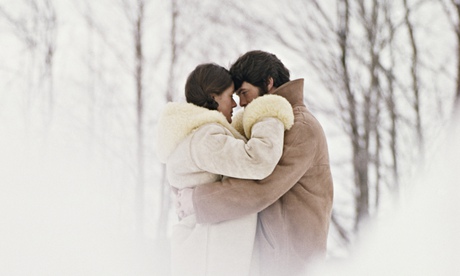
I like the way this week’s poem begins by arguing – not noisily, but with quietly casual insistence. “Snow” by Vidyan Ravinthiran, from his debut collection, Grun-tu-Molani, is a voyage around a subject that has brought out the best in a number of poets (not least Louis MacNeice). It might be in danger of melting under the heat of massed footfall. But Ravinthiran makes his own good snow: deep and crisp and surprising.
I’m tempted to say the poem is not really about snow. It’s an epistle or an epithalamium, a meditation on love and marriage, on the “dark alleys” of life and the illuminating flights. For Ravinthiran as for MacNeice, snow generates incorrigible plurality.
“The wrong type of snow” (Jim Naughtie’s witticism, often misattributed to British Rail) is the clever point of departure. Six stanzas of six lines each form the ports of call, a satisfying shape, like a sestina without the wrought-iron intricacy of repetition. If expectations of irony are disappointed at “a miracle/ of whiteness at the pane”, this is because, at that moment, the view is a child’s. It is an important view that will be returned to. Meanwhile, the eye moves on, grows up, with the observation that the ideal large snowflakes “dry out slow enough to watch drying out/ on the clothing of one you love”. This is a loving revision of that catch phrase about watching paint dry.
Americanisms (“anchors”, “emergency room”) help the poem’s residual romanticism to feel thoroughly remade. The snow-packed heart and the iced-up plane wings are evoked with pleasing immediacy and symbolic force, but now the speaker will leave the wrong snow to the reader’s deduction and explore the ideal. The thought is liberated by “the two kinds of white” – snow and ice? snow and sky? – and the wonder of the imaginative take off whispered in the first complete end-rhyme, a delicious if obvious conspiracy of “is” and “kiss”: “The difference between snow and water is/ the difference between dialectic and a kiss,/ between a birth certificate and spare change”. In the middle of the stanza, the poem deftly shifts emphasis from snow to cryostructure. Crystallisation is nature’s sestina-like magic. The seeming surrealism of natural phenomena nourishes the surrealism of the poet and, with “the super-slow-mo ripples/ of a cube of gelatine bounced off tile …”, scientific and verbal experiment bond pleasurably.
So much is going on in the final three stanzas of this essentially metaphysical poem that it might not be fanciful to think Ravinthiran’s technique is a kind of crystal construction, joining delicate new correspondences – between words and thought bubbles, the economy and the liquid “drapes and folds of statuary”, etc. Snowflakes are not merely softly ephemeral; they “plink at the glass” in stanza one and, in stanza four, are “slanted” so the “halo round a sodium lamp” is made to shudder. It’s a striking image that cuts deep.
Everything is flux, and death hovers in the allusion to the “bare ruined choirs” of Shakespeare’s despairing Sonnet 73. Colours are lost in white light, snow in its own water. Dissolution seems preferred to the rigidity that threatens post-childhood, “yet the snow we ball and build/ into forts we’ll live in when all grown up/ wants to change, always, into a white beard”. There’s a suggestion that forts of any kind are made to be unpacked and reduced to snowballs for snowball fights. The “white beard” image of youth and snow-play is, also paradoxically, also an image of age and holiness. The poem’s own dialectic renders transformation always possible. Snow has the tone and force of a fine love-poem, as well as a fine love-poem for snow.
Snow
What I’m saying is, this isn’t the right kind of snow.
Sure the anchors call it treacherous
but I’ve met it down dark alleys all my life. No,
snow should always be, as kids have it, a miracle
of whiteness at the pane, flakes large enough
to plink at the glass like a moth or a fingernail
and dry out slow enough to watch drying out
on the clothing of the one you love. Forget
the ice-box favoured in the emergency room,
it’s snow like this a heart comes bedded in.
And forget those now useless runways;
planes in mid-air grow sensitive,
the riveted metal of their wings goosepimples
as they go swooping through two kinds of white.
The difference between snow and water is
the difference between dialectic and a kiss,
between a birth certificate and spare change.
This much you already know. What you don’t know
is snow, is slanted crystals
the halo round a sodium lamp
can’t bear without shuddering.
While credit shifts and melts and hardens
and is lost, as the great man says,
as water is in water, his words are merely
so many thought-bubbles made visible
as we breathe in a snowy climate:
white shapes of breath that want, like the smoke
from a cigarette, or the super-slow-mo ripples
of a cube of gelatine bounced off tile, to be
the drapes and folds of statuary. The bare
ruined choir, the coloured glass is stained
to a white radiance and goes
without remainder into water, a new beginning;
yet the snow we ball and build
into forts we’ll live in when all grown up
wants to change, always, into a white beard.
• From Grun-tu-molani by Vidyan Ravinthiran (Bloodaxe Books).

